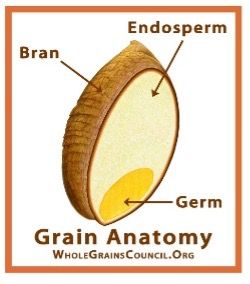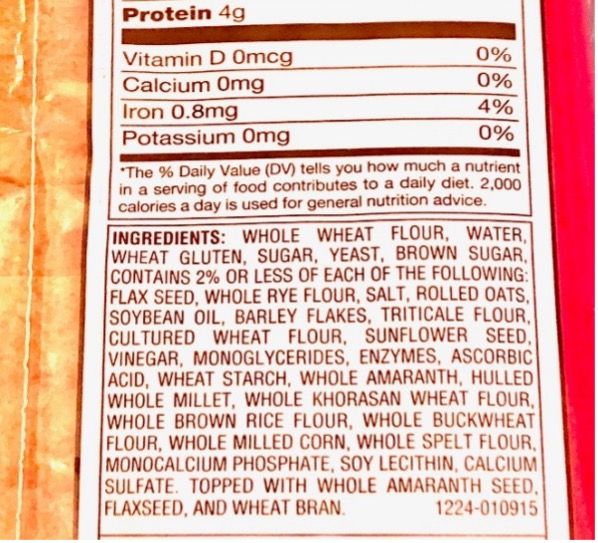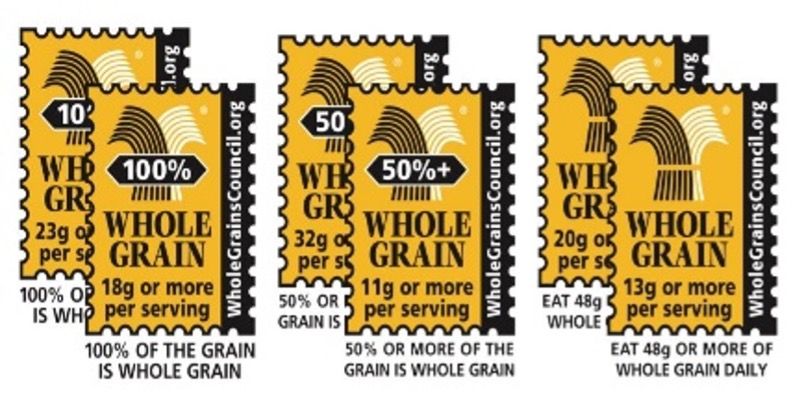MyPlate Foods to Increase: Whole Grains
MyPlate represents the most recent recommendations from the 2020–2025 Dietary Guidelines for Americans. It was designed to remind Americans to eat healthfully from all food groups (Figure 1). Eating whole grains is one way to make your diet healthier. Most Americans do not get enough whole grains in their diet. This publication provides information on whole grains and their health benefits as well as how to include whole grains in your diet.

Credit: MyPlate.gov
What are whole grains?
All grains start off as whole grains. They contain three parts: the bran, the germ, and the endosperm (Figure 2). The bran is the outer coat that protects the grain from sunlight, pests, water, and disease. This outer layer contains beneficial antioxidants, B vitamins, and fiber. The second layer is the germ. It contains B vitamins, protein, minerals, and healthy oils. The endosperm is the innermost layer of a whole grain. It contains carbohydrate, protein, and small amounts of vitamins and minerals.

Credit: WholeGrainsCouncil.org
The following are examples of whole grains:
- Whole-wheat flour
- Oatmeal
- Brown rice
- Wild rice
- Popcorn
- Whole-wheat cereal
- Whole-wheat bread
- Whole-wheat crackers
- Whole-wheat pasta
When whole grains are processed or refined, the bran and the germ are removed, leaving only the endosperm. Fiber and other nutrients are lost during the refining process.
Some of the vitamins and minerals lost during refinement are added back to the products labeled “enriched,” but fiber is not replaced. Therefore, enriched products, like white rice, are low in fiber compared to whole-grain foods.
Sometimes, it can be difficult to tell which products contain whole grains. One way to tell is by reading the ingredient list (Figure 3). The whole grain should be the first ingredient or the second ingredient after water. Many whole-grain products have the words “whole” or “whole grain” before the grain’s name on the list. For example, “whole-wheat flour” lets you know that it is flour made from whole grains of wheat.

Credit: Kim Griffin, UF/IFAS
An easy way to identify foods that contain whole grains is to look for the Whole Grain Stamp (Figure 4). There are three types of stamps: the basic stamp, the 50% stamp, and the 100% stamp. Foods with the basic stamp are guaranteed to have at least half a serving of whole grains, but may contain more refined grains than whole. Foods labeled with the 50% stamp indicate that at least half of their grain ingredients are whole grain. Foods labeled with the 100% stamp indicate that all of their grain ingredients are whole grain.

Credit: WholeGrainsCouncil.org
Why are whole grains important?
Whole grains contain vitamins, minerals, antioxidants, and other nutrients that promote health. Eating at least 3 ounces of whole grains per day has been shown to lower the risk of chronic diseases such as coronary heart disease, diabetes, and some cancers. According to researchers, the fiber in whole grain foods may help feelings of fullness to last longer. Eating more whole grains may be a contributing factor in weight management and obesity prevention.
How much do I need?
According to the USDA, at least half of your grains should be whole grains. The exact amount needed depends on your age and gender. This can range from five to eight one-ounce equivalents per day. (A one-ounce equivalent is equal to ½ cup of cooked rice, ½ cup of cooked pasta, 1 slice of bread, or 1 cup of ready-to-eat cereal.)
Only two percent of American adults meet the recommended intake for whole grains. National surveys indicate that most Americans eat less than the recommended amount.
How can you increase your intake of whole grains?
Whole grains fit into most budgets. Like with other nutrient-dense foods, customize your whole grain choices to reflect your personal preferences, geographic location, and family and cultural traditions.
Try the following suggestions to increase the amount of whole grains in your diet:
- Breakfast: Try whole-wheat cereal, whole-wheat toast, a whole-grain muffin, or oatmeal to start your day.
- Lunch: Use whole-grain bread or a whole-wheat wrap for sandwiches and have whole-grain crackers with soup.
- Dinner: Try brown rice as a side. When you eat pasta, choose one that is made with whole grain.
- Snacks: Choose unbuttered popcorn or whole-grain crackers.
There are plenty of other whole grains to try, too, like barley, quinoa, or wild rice. Barley is great when added to soups.
Quinoa and wild rice are simple to cook. Add one cup of quinoa to two cups of water, bring to a boil, and then simmer for 11–15 minutes. Wild rice is cooked the same way except that it needs about three cups of water and it has to simmer for about 45–55 minutes.
Try this recipe to add more whole grains to your diet.
Cranberry Nut Granola

Credit: iStock / Getty Images Plus
Makes: 16 servings (1/3 cup each serving)
Preparation Time: 10 minutes
Cooking Time: 25–30 minutes
Ingredients:
Nonstick cooking spray
3 cups rolled oats
1 cup chopped nuts
1/3 cup maple syrup or honey
¼ cup vegetable oil
1 tablespoon ground cinnamon
2 teaspoons vanilla extract
1 cup dried cranberries or dried berries of choice
Directions:
- Preheat oven to 325°F.
- Spray a large baking sheet with cooking spray and set aside.
- Combine oats and nuts in a large bowl.
- In a small saucepan, combine maple syrup, vegetable oil, and cinnamon. Cook over heat, stirring frequently until mixture becomes thin.
- Remove from heat and stir in vanilla.
- Pour warm mixture over oats and nuts, and stir to coat evenly.
- Spread mixture in an even layer on the baking sheet.
- Bake for 25 minutes.
- Put the cooked granola in a large bowl, add the cranberries, and stir until the cranberries are evenly distributed.
Store in an airtight container at room temperature for up to 7 days.
Summary
Whole grains provide a variety of health benefits and taste great, too. Although most Americans do not get enough whole grains, following the simple recommendations in this publication can help you meet the guidelines. When you look at your plate, remember MyPlate and add whole grains to the grains section. It is a great way to make your diet healthier.
For More Information
To learn more about whole grains, contact the UF/IFAS Extension Family and Consumer Sciences (FCS) educator in your county (look in the blue pages of your telephone book). UF/IFAS Extension offices are listed online at https://sfyl.ifas.ufl.edu/find-your-local-office/.
Recommended Websites
USDA’s MyPlate: http://www.choosemyplate.gov/
This site contains information about USDA’s MyPlate and all of the food groups.
Dietary Guidelines for Americans, 2020–2025: https://www.dietaryguidelines.gov/sites/default/files/2020-12/Dietary_Guidelines_for_Americans_2020-2025.pdf
Whole Grains Council: http://www.wholegrainscouncil.org
This site contains information on whole grains and the Whole Grain Stamp.




